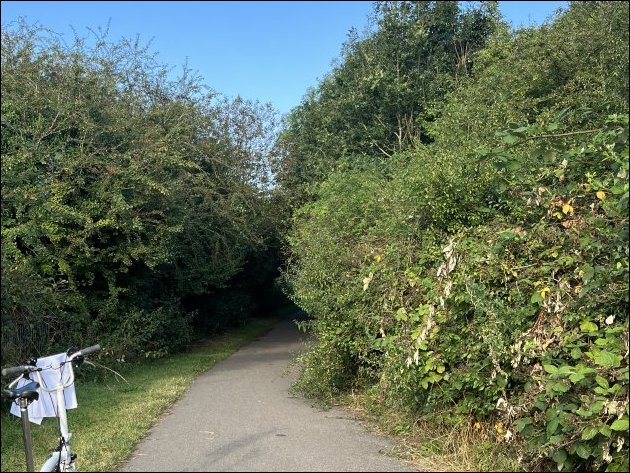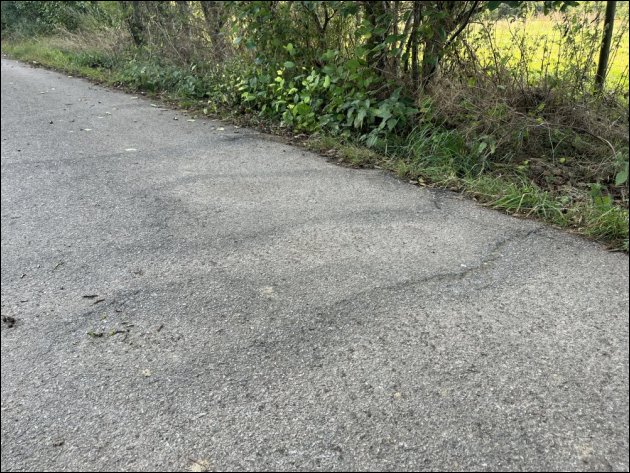The Chelmsford Marathon is on 13 Oct 2024, and I took the opportunity on Bank Holiday Monday 26 Aug 2024 to cycle the route and check out the road surfaces and the elevation. The Chelmsford Marathon definitely wins the prize for the most amusing street name.

When I ran the Milton Keynes Marathon in 2013 I was shocked by the state of the cycle paths (known locally as the Redways). I’ve been there many times, I’ve cycled some of the Redways, but I was still shocked by the poorly maintained ones on the edge of town. Redways that I had never seen until I was actually running the Marathon.
Given that unexpected distress, I was determined that it wouldn’t happen again. In 2018, before running the Geneva Marathon I went out and cycled the entire route. Hence, I knew exactly what the surfaces were like, and I knew where the hills were.
The same for the Chelmsford Marathon this year (2024). I’m a slow and cautious runner. I do not like uneven surfaces, ruptured tarmac, loose gravel, and grass. So I was keen to gain first hand knowledge of what I was letting myself in for. The event starts on footpaths and cycle tracks in Central Park, a short 500m walk from the railway station. As far as I can make out from the online map, this park bench in this photo marks the start and finish line, and just 75m further down that path you can see that all of the runners have to negotiate a weird cycle roundabout.

Then the fun starts! This surface looks awful! Pitted tarmac, sunken drains, acorns and debris. That’s right at the start! The first 200m are dire. Seriously, a different start line and first 200m would be welcomed by all the runners. And the malaise continues through Central Park and Admirals Park, for a mile and a half, on rough, unloved cycle paths.

There’s an extraordinarily tight 90° left turn, just after the bridge over the River Can in Admirals Park, and as soon as you round that corner, the undergrowth has commandeered about one third of the pathway. I was not impressed by what I’d seen so far.

More pitted tarmac. More tight corners. Vegetation growing through the surface. Ruptures where tree roots are just below the tarmac. And a generous supply of horse manure dotted here and there along the first 3 miles.


The route through Anglia Ruskin University has some vicious speed humps. I was on a Brompton Bike, with the original hard seat, and no suspension. The speed humps are massive and harsh, and would upset me equally had I been running and not cycling. The gate at the far side of the campus will presumably be open on race day, but I don’t like the look of that gravelly surface.

By the time I reached the 3 mile waypoint I was questioning whether I actually wanted to do this race! The first 3 miles will see me watching every single footstep and taking great care where I tread. Not fun!
At least the first 3 miles are flat.
When you join the small local road by Sturgeon’s Farm the mild undulations start. The surface also becomes much more in character with marathon running. A proper road, with some degree of maintenance. Except for some of the junctions.

These are junctions on minor country roads. Gravel abounds everywhere. Picking the best (and safest) running line through the junctions will require thought and judgement. If I’m boxed in by a group of runners, then it’s going to trouble me. From the outset, I need to have my own personal space, and be able to see the surface ahead. This race will be mentally taxing from the start.
In the interests of fairness, I should also say that some of the small local roads (taking the runners towards Willingale and back) are of a reasonable standard. About half of the 26 mile route, on and off, looks OK to me.


The ascents and descents don’t look bad at all. My Brompton has 6 gears. I normally start off in 3rd gear when travelling around London. When doing the gentle hills around Chelmsford I counted the number of times I had to shift down to 2nd or 1st gear. I selected 2nd gear 12 times to handle ascents, only needing to select 1st gear 3 times (12+3= 15 notable ascents). That tells me that there are only 3 times when I might have to slow to a walk. I expect to run the whole course this time. That wasn’t true of my first two marathons. I am going to do my utmost to maintain a dignified jog up those 1st gear hills, because there are only 3 of them, and because I have trained to run for longer, even on inclines. We’ll need to wait until the actual day to find out if that plan works.

There are a number of places where the tarmac surface has given up, and Mother Nature is reclaiming the centre of the road. Some of it is fairly extensive like this photo near Millers Green. In other places, like Wood Lane past Sawyer’s Farm there are sporadic oases of greenery flourishing on the centre line of the road. Random plant life erupting in vibrant shades of green. It all means that I will be picking out the racing line with care for much of the 26 mile route.
Serendipitously, there is one stretch of recently laid, quality tarmac at about mile 21. It’s nice, especially as it’s on an uphill stretch. The whole route should be like this.

However, the good news doesn’t last long. After about 800m of beautiful, new tarmac, the route turns left onto a regular country road towards a hamlet called Newney Green (on a road also called Newney Green). Having missed the chance to get some perfectly ripe blackberries at about mile 16, I stopped at about mile 22 to collect an ample supply.

Soon after that, the route returns us to the uniform “out and back” stretch passing the weirdly named “University College Cow Watering Campus”. And promptly brings us back onto the aforementioned cycle paths and foot paths for the final three miles. It’s also known as a “permissive bridleway” though I’ve never seen a sign like that before. It contains ample supplies of horse manure, ruptured and pitted tarmac, and is clearly an uncared for and unloved pedestrian and cycle route.
The final stretch is perfectly fine for gentle recreation, casual walkers and casual cyclists. It’s not my idea of what a marathon course should be like. Overall, it’s better than Milton Keynes. But it’s not as good as Geneva.
Perhaps I’m being unfair? Is my brain conditioned by the marathons I’ve seen on TV? Are normal marathons supposed to contain miniature obstacle courses?
I’m so glad that I did the recce before doing the race! I know exactly what I’m letting myself in for. Yes, I will do the Chelmsford Marathon. It will be both physically demanding and mentally demanding. Which is what all my training runs are like anyway!
Buy “The Third Marathon” on Amazon






